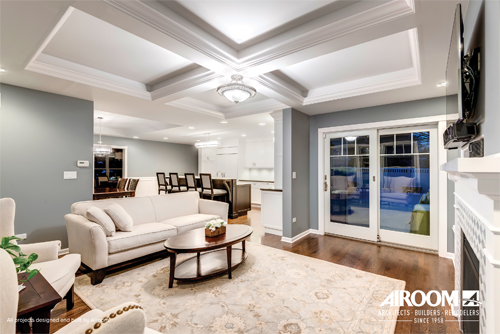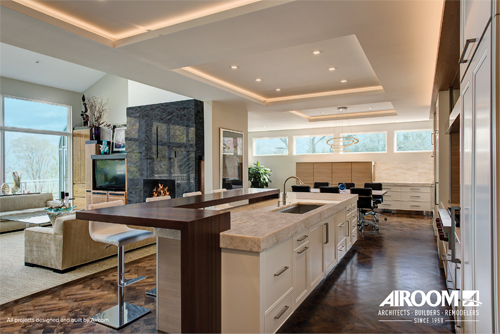Building a new home, or having significant remodeling done on your existing house, is no small undertaking. Not only does it costs hundreds of thousands of dollars, but the process can take six to 12 months (or longer!). That’s why it’s so important to choose the right professionals to handle your home construction or renovation project.
“Building a home is, for many, a once-in-a-lifetime experience. It is also likely the most expensive lifetime event,” says Evanston architect Nathan Kipnis.
There can be a number of professionals involved in the process of building a house — an architect, general contractor, builders, subcontractors. What you want to avoid, says Marty Meadow, senior vice president of Airoom, is signing separate contracts with an architect and a builder who have conflicting responsibilities.
“The best approach to almost any remodeling project is working with a design-build team,” says Meadow. “This means there’s one point of responsibility for the entire project — no finger pointing that the architect missed something or that the builder didn’t understand a specification. It often saves you money in the long run to bring everything under one team.”

There are many concrete factors to consider before hiring your design-build team (more on that below), but one highly subjective aspect can make or break the whole process: personality. Wilmette architect Chad Boomgaarden says your initial meeting with a prospective architect is kind of like a first date — you can tell within a few minutes whether you’re a match. Trust your intuition, he says, because you’ll be working closely with that person for several months.
“Your architect will be your advocate throughout the duration of the project, being on site to respond to both your and the general contractor’s stylistic and technical questions,” Boomgaarden says. “This all has to be handled without ego, and efficiently, so that you are achieving your desired aesthetic while staying on budget and schedule.”
Know when to skimp and when to splurge
You’ll be spending a pretty penny on the quality construction or renovation of your home, so Kipnis says not to skimp by simply hiring the cheapest architect. The difference in fees from one firm to another is probably only a few thousand dollars — a small percentage of the overall project cost.
“If you select a ‘cheaper’ architect and get a poor design, no matter how good everything after that is done, it will only be as good as the bad design is,” Kipnis says.
The cost of construction has been going up because labor and materials are more expensive. Kipnis says to ask prospective design-build teams what they are seeing for the typical cost per square foot for construction projects similar to yours. Northbrook homebuilder Jeffery Rothbart says you should expect your architect to be budget savvy. Get an understanding of how he or she intends to “value engineer” your project.
“Every project is likely to flirt with the top of the budget, and it’s important that the builder know where to save money,” Rothbart says. “Too many builders don’t know the true cost of many components of the home.”
Questions to ask before you sign a contract
As with most things, word of mouth is a good way to identify reputable architects and design-build teams. Kipnis says you should check the company’s website to see what design awards the firm has won and which publications they’ve been featured in. You should also ask to see examples of projects similar to the one you have in mind. Kipnis says to ask potential architects whether they provide 3D renderings.
“Most clients don’t want to admit it, but it is very difficult for lay people to read blueprints,” he says. “There is nothing better than the ability to ‘walk’ through a design, changing the materials and colors on the fly, and seeing the sun move through the space.”
Heritage Luxury Homes’ Milena Birov says to find out how many years a company has been in business and how many houses they’ve built. Also get information about warranties, structure of payments during construction, and what features are included in the asking price.
“The best is to obtain a written specification, which describes the materials and components of every room of the house, so there are no surprises later,” Birov says.
Boomgaarden says to ask potential architects how they handle scope changes and related fees. It’s also important to know who the main point of contact will be for your project.
“The owner should know if they are paying for an associate, or the principal of the firm, to be on site responding to the owner’s and general contractor’s stylistic and technical questions,” Boomgaarden says.
You assume your architect knows about things like load-bearing walls and permit requirements, but what about things like kitchen and bathroom finishes? Meadow says that “icing on the cake” can be just as important as the overall structure of a house.
“If they don’t personally know those details well, do they have specialists in these areas on their team?” Meadow asks. “These elements will make or break the look of the home.”

Northfield architect Doug Reynolds offers this checklist of questions to ask design-build candidates:
- Who will actually be doing the design? Will it be a licensed architect or intern?
- Does the architect/builder provide any guidance on finish selections or is the client expected to provide?
- Is the architect truly part of the design-build team or just an add-on resource to produce drawings?
- How will the fees be structured? Hourly? Percentage of construction cost? Set fee?
- Who will own the drawings during design phase, should you decide to part ways prior to completion of plans? Who will own the drawings once they are completed and ready for bidding? “In other words, can the owner walk away and use the plans with another builder if they can’t come to an agreement on pricing with the initial builder?” Reynolds asks.
- Does the architect/builder have the right to replicate the design nearby or at all? “You may not want to see duplicates of your home around town,” Reynolds says.
The importance of sustainable design
Kipnis says sustainable design should be considered a must-have rather than a luxury. It is now possible to design “net-zero” buildings that produce as much power as they use, for minimal additional cost. Kipnis has designed buildings that have no natural gas lines, all electric HVAC and appliances, and substantial solar electric systems and battery backup systems.
“Buildings that don’t incorporate significant sustainable features will have issues with resale down the line, and are out of step with what needs to be done for the environment — they will be dinosaurs before they are even completed,” Kipnis says.
Inquire about potential architects’ experience with sustainable design. Ideally, Kipnis says, they should be LEED accredited or have some other green certification such as Certified Passive House Consultant.
Don’t ignore these red flags
Even if an architect or design-build team meets your basic criteria, don’t ignore the red flags below:
- Kipnis says to be weary of a portfolio that is all the same style of work — unless that style is exactly what you’re looking for.
- Ask to do a walk-through of one of the architect’s projects, and if you see things like nail pops, settling cracks, seams or uneven textures on walls, Reynolds says that could be a sign of shoddy work.
- Watch out for what Reynolds calls “iPad general contractors.” “This is a term for those who have no actual experience in architecture or construction, but decided to leave their past profession and build houses instead,” Reynolds says. “They send lots of emails and instant messages to suppliers and subcontractors from their smart phones, but have little understanding of the hands-on direction and oversight that is truly needed to ensure a quality home and safe job site.”
- Prospect Heights architect Jereme Smith says to avoid architects who seem too busy or those who have a style that isn’t in line with yours.
- Too many opinions — or too few — can be a red flag, according to Meadow. He says you want someone with experience, but who is willing to put their preferences aside in favor of yours. “Another big red flag is if they’re not detailed or want to jump right in and leave details for later,” Meadow says. “That’s almost as bad as not letting you make your own design choices. You’ll want to have everything specified before starting anything.”

